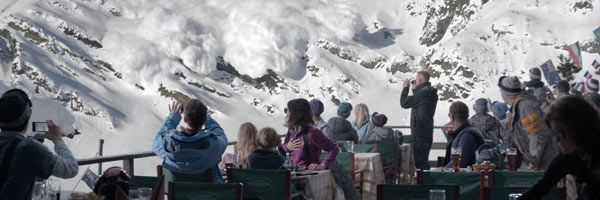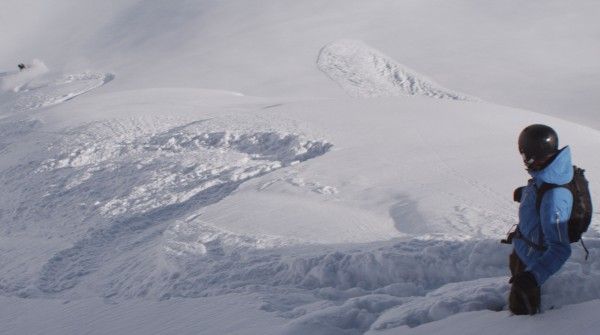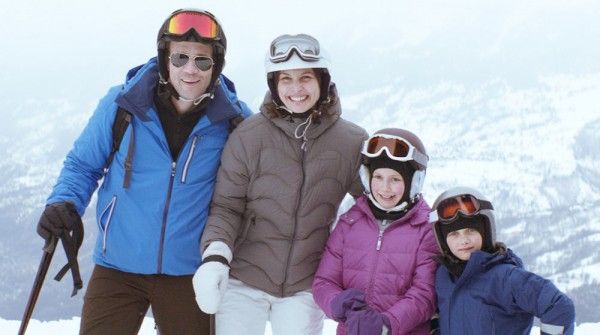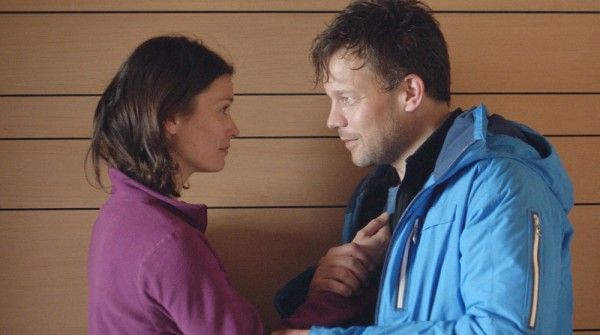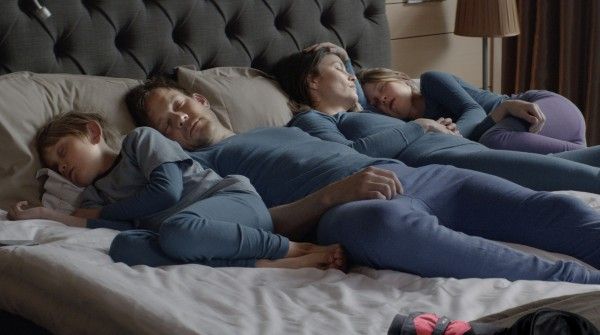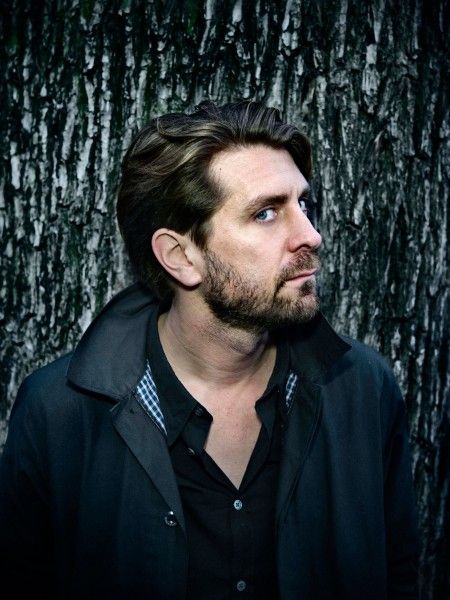Force Majeure, Ruben Östlund’s wickedly funny and precisely observed psychodrama about a model Swedish family on a skiing holiday at a five-star resort in the French Alps, is Sweden’s official Oscar entry for this year’s Best Foreign Language Film. When family patriarch Tomas (Johannes Kuhnke) makes a split second decision in the face of an unexpected crisis, his relationship with his wife (Lisa Loven Kongsli) and children (Clara & Vincent Wettergren) begins to unravel. Opening in New York today and in Los Angeles on October 31st, the film also features Kristofer Hivju and Fanni Metelius.
At our roundtable interview, Östlund and Kuhnke talked about the influence of Stanley Kubrick and Luis Buñuel on the film’s visual style, filming the avalanche scene, Östlund’s directing style, shooting 30 to 50 takes of each scene to allow the actors to develop the feelings and emotions of the characters, wanting to tell a story that highlights expectations about gender, the sociological studies that inspired the film, the appeal of playing Tomas, the power of moving images to change human behavior, Östlund’s criticism of the Hollywood film industry and the way filmmakers like Quentin Tarantino are reproducing a certain kind of character, and his upcoming feature The Square. Check out our interview after the jump.
QUESTION: There’s a Kubrick-esque feel to this film in terms of the visual style, the camera movement, the music, and the story of a family at a resort whose relationship starts to unravel. Can you talk about the tone you wanted to achieve?
RUBEN ÖSTLUND: The tone of the film that I was aiming for was to have strong humor mixed with dramatic moments and awkward silence and awkward situations. For example, in the scene with the avalanche, there’s one sentence that I’m very proud of. It’s just before the avalanche is triggered, which is where the kid asks, “Isn’t there any Parmesan cheese?” And then, the avalanche is triggered. So, I’m trying to find that kind of humor. I tried to highlight the pressure that is building up between the couple and within the family. When it comes to the scenes that are in the hotel, there are a little bit longer static shots. That’s maybe why it reminds us a little bit of Stanley Kubrick’s The Shining. Also, we are not using music to highlight any emotions and we work with this kind of very uncomfortable silence. In the end, we just look in the characters’ eyes and see their emotions.
How did you shoot the avalanche scene which sets up the rest of the film?
ÖSTLUND: The avalanche was actually shot in British Columbia and we build the restaurant in the studio in Gothenburg, Sweden where I work and live. It’s a combination of a green screen and a real avalanche, then snow smoke that we were shooting in on set, and also CGI afterwards. We had high goals with that scene. One of the goals was we wanted to create the most spectacular avalanche scene in film history. Maybe you can say if we have succeeded or not.
You have several scenes in the hotel where the housekeeping employee is looking down at the couple from the balcony above. Can you talk about the significance of those scenes?
ÖSTLUND: In those scenes, where the hotel janitor is looking at the couple, he represents someone who is from another social and economic situation than the family. This is also a question about a certain kind of lifestyle. They have this luxury five-star hotel that they’re going to. They have those electric toothbrushes in their mouths. They have all the resources and they have all the time. The kind of problems that you get in a couple’s relationship is very connected to a certain type of lifestyle. I think it’s a bit provocative that we are allowed to put so much energy into those couple relationship problems. The culture is telling us over and over again that this is what we should focus on in our lives. So the janitor is watching this couple and wondering what they are doing. They’re well-to-do Swedes and he’s having that perspective of their problems. In one way, I think it’s interesting to let the film take place at a ski resort where all those people have neon-colored ski clothing and mirror lenses on their goggles. These are people that are in control of their lives. We make them face a human mechanism that you mostly meet when you are looking at troubled areas what there is war or there’s a natural catastrophe or those kinds of things. I thought it was interesting to expose them to this kind of situation that elicits their most basic instinctual behaviors.
At the end, when they abandon their bus, it’s a little reminiscent of The Discreet Charm of the Bourgeoisie. Can you talk a little bit about that influence?
ÖSTLUND: Exactly. I loved that movie and I liked that. That was one of the ideas with that scene to have all those tourists that are dressed to be at an airport. They have high heels and not much clothing, and suddenly they are on this solitary road high up in the mountains, and they don’t know how far they need to walk. They don’t know where the bus is stopping and they have been left behind. I was also interested in letting them walk and in the beginning feel a bit ashamed that they may have overreacted when they left the bus. But after a while, as they are walking, they realize that this is what it’s like to be human, and they feel something when they are walking together. There’s another thing that I also like about the bus scene. It’s the character of Charlotte who’s been living this sinful life during the week. She has different guys every night. When we see her sitting in the bus after everyone else has stepped off, it’s almost like we want her to crash down the mountain so she will be punished for her sinful life. But instead, she’s the only one that goes on to the airport and catches her flight. It was an unconventional way of treating a character like that, because very often those characters are punished at the end of the movie for their radical lifestyle.
The beautiful visual compositions and the narrative wouldn’t work without the great performances of the actors. As a director, are you very hands on with the actors or does it vary on a case by case basis when you’re constructing the film?
ÖSTLUND: I think the actors take a great responsibility for the characters in the movie. It works best for me directing when we feel confident and are there to try out things that we wouldn’t try out if we had a really strict way of shooting. At most, we have two camera positions a day. Sometimes we have one camera position for three days. When we have one camera position, and we’re just pointing at one actor, and then on the actor’s face only, it’s interesting to see. It felt like we could reach a higher level of acting just by repeating it over and over again and really have time to find out how we can highlight the colorful parts of this scene. How do we bring out the things that we are interested in? How do we make it in the best way?
JOHANNES KUHNKE: Every scene is shot between 30 and 50 times so we can actually go deeper and deeper into the feeling and the emotion and try to develop it, and even as you say, be daring and try out new things during the first 10 takes. So, it’s the communication between the actors and the director.
Would you say that sometimes on the fortieth take, maybe when you’re tired and emotionally spent, good work comes out and is revealed?
KUHNKE: I have an idea about that. In the casting process, I think you sort out those actors and you can do less than 40 takes, because you do it over and over also in the casting. I mean, you know that before you’re going to shoot. So you’re really aware of it and you use it. I can use the first attempt to be bold, to be brave, to do things, and Ruben can direct me and say, “No, that was too much,” or “Go there,” or “Oh, this is interesting,” or something like that. So I think it was fine.
The bus sequence reminded me of being in Switzerland and going around those mountains with the hairpin curves. Did you have the actors do it 20 times?
ÖSTLUND: Oh yeah.
KUHNKE: The first time we did it I texted my wife and kids to say, “Thank you for everything. This might end badly.”
ÖSTLUND: We were inspired by a YouTube clip when we shot that sequence in the bus. You can look it up on YouTube. It says “Idiot Spanish Bus Driver Almost Kills Students.” It’s almost the exact same scenario.
This is one of two films you’ve written alone. Can you talk a little about your research and the themes you wanted to develop?
ÖSTLUND: Yes, I wrote Play alone also. For me, it was a quite easy film to write, because the core of the film, the scene with the avalanche, is so strong and raises so many questions. For me, it was quite obvious that this was highlighting something about expectations when it comes to gender and the role of the man and the role of the woman. I used some sociological studies as an inspiration for the film also. There was one about airplane hijackings. You can tell that the frequency of divorce is extremely high after airplane hijackings. They’re like crisis situations where suddenly you see a side of your partner that makes you think, “I don’t want to continue living with this person anymore.” And the other one was about a ship catastrophe. The funny thing about that is I think we have so many prejudices about how we act in a situation like that. A lot of those myths are based on how we think the Titanic [disaster] took place and the myths about women and children first and the captain staying on the ship until it goes down to the bottom of the sea. But when you look at the statistics, and this is also for the Titanic, the ones that survive are men of a certain age and the ones that perish are women and children. Actually men are closer to having the ability to act egoistic when it comes to a crisis situation. So many times after a catastrophe like 9/11, Estonia in Sweden, the Holocaust or whatever, we are so fond of lifting up the hero examples, but actually 99 percent of survivors have done something that they feel very guilty about. Just look at the history of cinema. The most reproduced male character is probably the hero and the most reproduced female character is probably the sex object. I think those stereotypes have been reproduced over and over again. It also changes our expectations when it comes to a situation like this in real life. I was using a lot of these things as a base when I was writing the script. I wanted to bring it out in the different scenes. I added characters that could highlight something about the conventional nuclear family lifestyle.
Why did you choose Force Majeure for the film’s title? Is it the avalanche which is an act of God or is it the instincts that people follow to save themselves?
ÖSTLUND: I think it’s a good title because the avalanche becomes a metaphor in many ways. The ski resort almost becomes a metaphor. It’s like a struggle between the forces of nature and the civilized man who is trying to hold back the uncivilized side of himself. Force Majeure means major power in French and it’s like a power that we don’t control. We don’t know how to handle a situation when we’re exposed to it. It’s used like a legal term when it comes to insurance. If you look at a marriage, it’s also a legal agreement. So I think there are many things about that title that bring out subjects in the film.
Johannes, what was the appeal of the role to you? When you first read the script, what drew you to it and made you say this is something I want to do?
KUHNKE: As Ruben mentioned earlier about reproducing the character of the hero, I had played so many heroes, so many nice young men in love fighting for a higher meaning. So, I was really longing to play a more complicated part and I think it is something with age as well. I’ve done that, and now I’ve played Humbert Humbert in Lolita, so I had to begin to do something with really nasty feelings.
As a filmmaker, do you feel that one of the most important elements of filmmaking is not just being technically proficient with a camera or the editing, but also having a strong point of view or an aesthetic and having something to say?
ÖSTLUND: Why I’m interested in filmmaking is because a moving image is very, very powerful when it comes to changing human behavior. I have been interested in that topic for quite a long time. I heard examples from Roberto Saviano, the author of Gomorrah. He said in an article that six months after a Quentin Tarantino movie was released in the world, the young gangsters in Naples started shooting with a gun on the side. So, even though it’s very inefficient and dangerous to shoot with a gun on the side, they’re running around shooting at each other, and the shootouts became very bloody, and the police had a mess cleaning up afterwards. It’s very important for me to leave references of life that I actually agree on when it comes to Force Majeure. I want my film to be possible to use as a reference when we are trying to live our lives. I would definitely say that the content of the film has to in some ways. Yeah, I’m not a genre film filmmaker. I’d rather look for a topic that I think we need to bring up and discuss because there’s something about the issues in the film. It’s highlighting something that we are actually terribly wrong about. I’m a professor now at a university in Gothenburg in Sweden (The School of Gothenburg) and I’m starting to teach students at film school. I think more and more we are focusing on content and less on the professionism when it comes to filmmaking because that technique is so much closer to us nowadays. I mean, the young students that come through the school are already very, very skilled in making it look very good. So what we need to focus on these days is the content of the films. I’m quite critical of the way the Hollywood film industry is reproducing a certain kind of character, reproducing images that I think actually change human behavior in a bad way many times.
Are there any other directors or moments in film that you took as inspiration?
ÖSTLUND: Well actually I would like to recommend another YouTube clip that is called Taxi Driver Interview. I don’t know if you have seen it. It’s so funny. It’s a taxi driver who ends up in a BBC interview and he is mistaken for being an expert on internet rights. So when the journalist is introducing him, she says, “Welcome to Guy Kewney, blah, blah, blah.” In the moment when she says Guy Kewney, you see how this taxi driver is trying to avoid losing face and he starts to play the role of Guy Kewney. It highlights the fear that we have of losing face in front of each other and how we are also playing parts in our own life. We are acting out what we think is expected of us. You must see that interview. It is so bizarre because they are just saying nonsense and the journalist is not listening to what he is saying. She just continues and asks the next question, and he goes, “Yes, you can go to a cyber café and you can download music anywhere. It’s much better for development.” I would really like to recommend that.
What are each of you working on next?
ÖSTLUND: I’m working on a feature film called The Square. I’ll talk about the thematic of the film. Since 2008, Sweden has started to build gated communities. Before then, gated communities didn’t exist. So there’s been a radical change when it comes to what we had in common and how we treat what we have in common, the responsibility we take when it comes to society. We are setting a difference between society and state which makes us as individuals take less and less responsibility for each other in public spaces. It’s like a major change in attitude when it comes to which way we should run society. The Square is a film that will bring up this question and we will do it with a physical square in this film. There will be a white-marked square that is in the center of the city in a strategic place, and you can use this square if you are in need of help. You can go and stand in the square. And then, the people that are passing by have to address you and say, “How can I help you? I see you’re standing in the square.” If you are tired and you don’t want to carry your luggage, you can put the luggage in the square, because in the square, we are not allowed to steal. The Square, of course, also has a philosophical level and not only a practical level, because what are the rules outside the square? Are we allowed to steal something outside the square then? So that’s the next movie.
KUHNKE: I just got representation here in Los Angeles and I’m going home for some castings. And then, of course, I would love to work with Ruben again.

